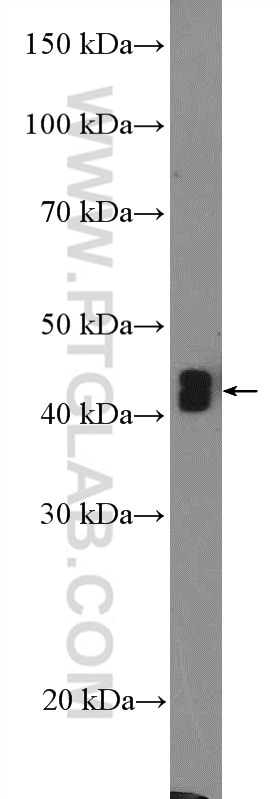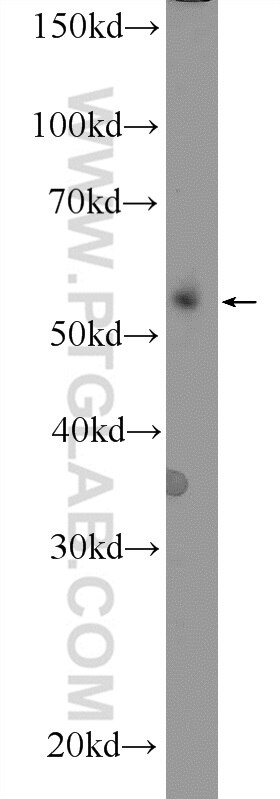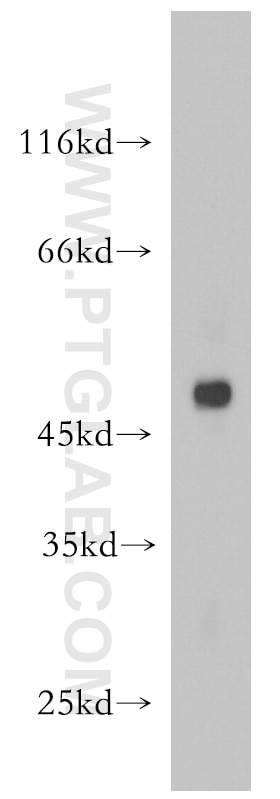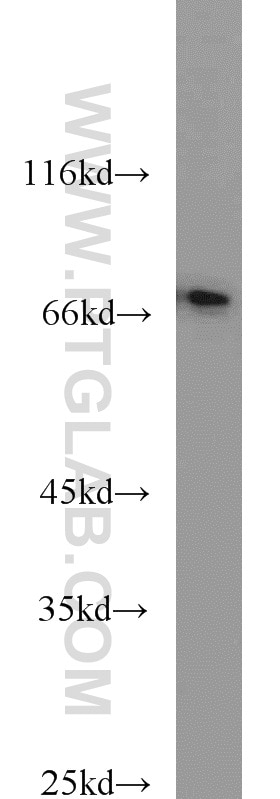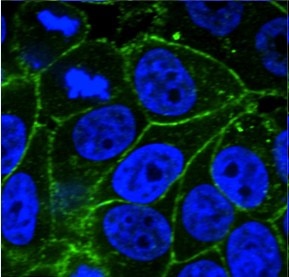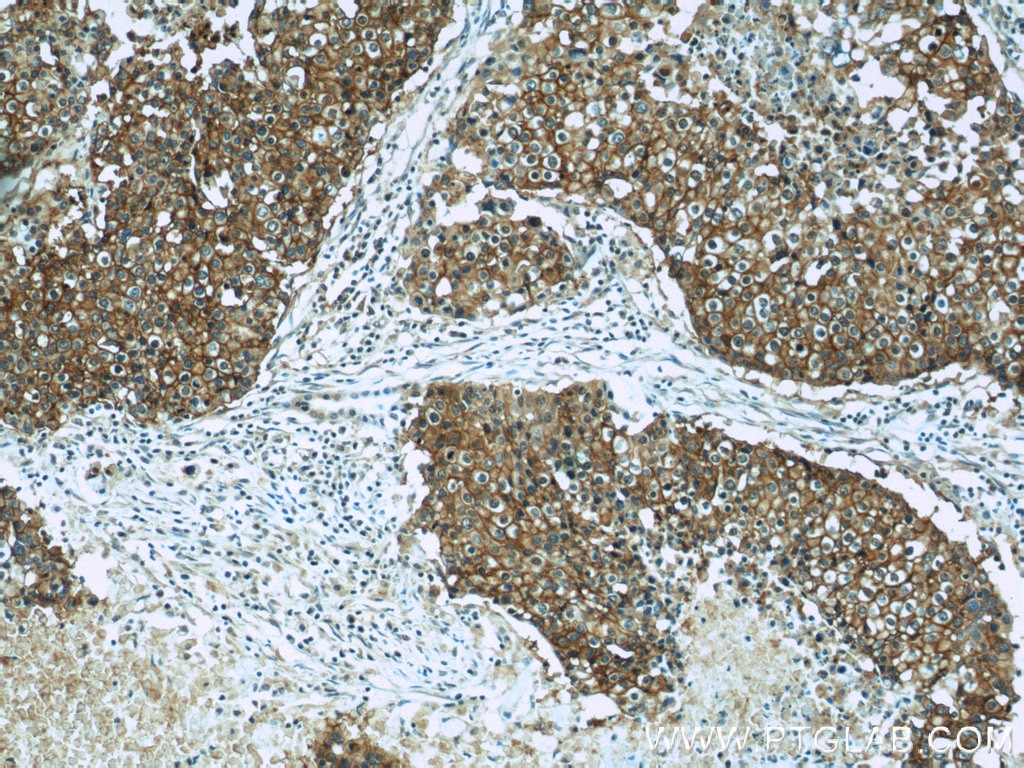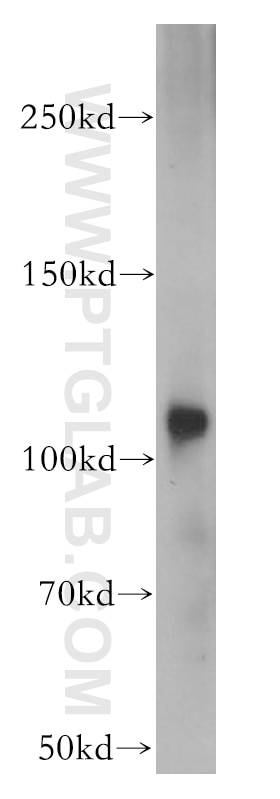CD24 Polyklonaler Antikörper
CD24 Polyklonal Antikörper für WB, ELISA
Wirt / Isotyp
Kaninchen / IgG
Getestete Reaktivität
human, Maus und mehr (1)
Anwendung
WB, IF, ELISA
Konjugation
Unkonjugiert
Kat-Nr. : 18330-1-AP
Synonyme
Galerie der Validierungsdaten
Geprüfte Anwendungen
| Erfolgreiche Detektion in WB | MCF-7-Zellen, Mausmilzgewebe, Raji-Zellen |
Empfohlene Verdünnung
| Anwendung | Verdünnung |
|---|---|
| Western Blot (WB) | WB : 1:500-1:1000 |
| It is recommended that this reagent should be titrated in each testing system to obtain optimal results. | |
| Sample-dependent, check data in validation data gallery | |
Veröffentlichte Anwendungen
| WB | See 10 publications below |
| IF | See 1 publications below |
Produktinformation
18330-1-AP bindet in WB, IF, ELISA CD24 und zeigt Reaktivität mit human, Maus
| Getestete Reaktivität | human, Maus |
| In Publikationen genannte Reaktivität | human, Maus, Ratte |
| Wirt / Isotyp | Kaninchen / IgG |
| Klonalität | Polyklonal |
| Typ | Antikörper |
| Immunogen | CD24 fusion protein Ag11679 |
| Vollständiger Name | CD24 molecule |
| Berechnetes Molekulargewicht | 8 kDa |
| Beobachtetes Molekulargewicht | 30-70 kDa |
| GenBank-Zugangsnummer | BC007674 |
| Gene symbol | CD24 |
| Gene ID (NCBI) | 100133941 |
| Konjugation | Unkonjugiert |
| Form | Liquid |
| Reinigungsmethode | Antigen-Affinitätsreinigung |
| Lagerungspuffer | PBS mit 0.02% Natriumazid und 50% Glycerin pH 7.3. |
| Lagerungsbedingungen | Bei -20°C lagern. Nach dem Versand ein Jahr lang stabil Aliquotieren ist bei -20oC Lagerung nicht notwendig. 20ul Größen enthalten 0,1% BSA. |
Hintergrundinformationen
CD24 is a cell surface signal transducing molecule, which is also known as a cluster of differentiation 24 or heat stable antigen CD24 (HSA) (PMID: 7959762). It is a sialoglycoprotein that is anchored to the plasma membrane via a glycosylphosphatidylinositol (GPI) link. Due to its cell surface localization, it contributes to a wide range of downstream signaling networks and has been shown to play crucial roles during neural development (PMID: 27993646) and the differentiation of various cell types. For example, it promotes antigen-dependent proliferation of B-cells, while preventing their terminal differentiation into antibody-producing cells (PMID: 11313396). CD24 may also play a role in apoptosis regulation, as cross-linking of this protein on the surface of neutrophils induces cell death, which seems to be defective in sepsis (PMID: 24501201). In addition, CD24 has been linked to negative regulation of the immune responses, particularly to danger-associated molecular patterns (DAMPs) (PMID: 24996822).
What is the molecular weight of CD24?
According to NCBI, there are two known isoforms of CD24; the shorter 80 aa (8 kDa) isoform 1, which is considered a canonical sequence that has been experimentally validated, and a longer 120 aa (12,9 kDa) protein (PMIDs: 16344560, 15489334). Isoform 1 is further processed into a mature 32 aa form. Apart from these, 3 potential computationally mapped isoforms have been suggested. The CD24 gene locus is localized on chromosome 6, while other non-transcribed loci have been found on chromosomes 1, 15, 20, and Y (PMID: 7959762).
What is the subcellular localization of CD24?
It is a cell surface protein that can act as an adhesion molecule.
What is the tissue specificity of CD24?
As a rule, CD24 tends to be expressed at higher levels in progenitor cells and metabolically active cells and to a lesser extent in terminally differentiated cells (PMID: 25613900). CD24 is specifically expressed in a number of B-cell lines, granulocytes, and differentiating neuroblasts (PMID: 8753773, 12447971). The expression is lost when primary B-cells are induced to differentiate in antibody-forming cells. CD24 expression has also been linked with various malignancies: epithelial neoplasms (PMID:16164042), erythroleukemia cell and small cell lung carcinoma cell lines. For certain cancers it is considered a prognostic marker, usually associated with poor patient prognosis, e.g., colorectal cancer (PMID: 16166435) and ovarian cancer (PMID: 2368195).
What is the involvement of CD24 in disease?
As mentioned before it is considered a prognostic marker in various malignancies. However, it is also clearly associated with multiple sclerosis (MS). Indeed, a single nucleotide polymorphism V57A has been associated with an over 2-fold increase in the susceptibility to MS and has been generally linked to a quicker progression of the disease in the general population (PMID: 14657362).
What are the main roles of CD24?
Considering its expression patterns, it is clear why CD24 plays the most important roles in immune cells. It can be used as a marker for the differentiation of hematopoietic and neuronal cells, in addition to tissue and tumor stem cells (PMID: 12447971). CD24 has also been found to mediate apoptosis in precursor-B acute lymphoblastic leukemia cell lines in the pro-B and pre-B stages accompanying activation of multiple caspases (PMID: 12496407). It has also been shown to play a role in autoimmune responses, as CD24-deficient mice are resistant to autoimmune encephalomyelitis (PMID: 10791997).
Protokolle
| Produktspezifische Protokolle | |
|---|---|
| WB protocol for CD24 antibody 18330-1-AP | Protokoll herunterladen |
| Standard-Protokolle | |
|---|---|
| Klicken Sie hier, um unsere Standardprotokolle anzuzeigen |
Publikationen
| Species | Application | Title |
|---|---|---|
Cancer Lett Cancer stem-like cell characteristics induced by EB virus-encoded LMP1 contribute to radioresistance in nasopharyngeal carcinoma by suppressing the p53-mediated apoptosis pathway. | ||
Cancer Cell Int SOCS6 promotes radiosensitivity and decreases cancer cell stemness in esophageal squamous cell carcinoma by regulating c-Kit ubiquitylation. | ||
Biomolecules COL11A1-Driven Epithelial-Mesenchymal Transition and Stemness of Pancreatic Cancer Cells Induce Cell Migration and Invasion by Modulating the AKT/GSK-3β/Snail Pathway. | ||
Acta Biochim Biophys Sin (Shanghai) miR-345 inhibits migration and stem-like cell phenotype in gastric cancer via inactivation of Rac1 by targeting EPS8. | ||
J Oncol Acidic Tumor Microenvironment Promotes Pancreatic Cancer through miR-451a/MEF2D Axis. |
